Media
Museum Crossword 5/3/20

Join us every Sunday for games inspired by museums and collections.
This week’s participating museums: Air Force Space & Missile Museum, Akron Art Museum, Ancient House Museum of Thetford Life, Berkeley Art Museum and Pacific Film Archive (BAMPFA), Black Belt Museum, Canadian Museum of History / Musée canadien de l’histoire, Contemporary Jewish Museum, Cumberland Heritage Village Museum, Eastern State Penitentiary, Erie Canal Museum, Genesee Country Village & Museum, Georgia Museum of Art, Joliet Area Historical Museum and Old Joliet Prison, Lynn Museum, Pueblo Grande Museum, Royal Saskatchewan Museum, Stories of Lynn, The Wolfsonian–FIU
Play online or download the PDF. (Last week’s answers)
Across
1
Card or Mail order
3
Green Bay or Art
5
The duchess of where opened the Ancient House Museum in 1924? Ancient House Museum of Thetford Life has a hint.
6
The mighty ____ rocket began as America’s first intercontinental ballistic missile, but ended up launching four crewed Project Mercury missions into space in the early 1960s. The Air Force Space & Missile Museum has more.
7
Hangs on a gallery wall
11
Civil War era “texting” code. Learn more at the Genesee Country Village & Museum.
13
Material used to collect maple sap or make canoes. More at the Canadian Museum of History / Musée canadien de l’histoire.
14
Apex predator of the Cretaceous oceans and recent co-star in the Jurassic World movies. Black Belt Museum can give you a hint.
16
Serial number for collections
17
Codex
18
Makes galleries look good
20
Citation entry
22
This crooner’s love of Levi’s gave rise to the term “Canadian tuxedo.” The Contemporary Jewish Museum has more.
26
An object made or used by a human being. Pueblo Grande Museum has many.
27
The Kings Lynn Archive holds quarter sessions listing which Witchfinder as a witness? Learn more at the Stories of Lynn.
28
Maker of exhibitions
DOWN
2
A place to get art
4
What type of oil powdered the lamps at St Margaret’s Church in Kings Lynn until 1829? Lynn Museum has a hint.
5
Now shrinking around the globe, they dramatically impacted life in the Pleistocene and shaped the geography of the Great Plains. Learn more at the Royal Saskatchewan Museum.
8
Early 20th century Swedish artist, whose abstract paintings predate Kandinsky, Malevich, Mondrian, and Klee but only recently received international attention. Berkeley Art Museum and Pacific Film Archive (BAMPFA) can give you a hint.
9
Brother to Elwood: Joliet _______. Learn more at the Joliet Area Historical Museum and Old Joliet Prison.
10
This German emigre who designed a desk and chair in the Wolfsonian collection was also the architect and designer of the Walt Disney studios in Burbank. Learn more at The Wolfsonian–FIU.
12
The work of museum curators
13
You can make this environmentally themed craft out of two toilet paper rolls with a little imagination. The Georgia Museum of Art has instructions.
15
Keeper of a museum’s history
19
In printing, when you run out of letters you are out of this. Synonym for unhappy or unwell. Explore Cumberland Heritage Village Museum for more.
21
Resides at the bottom of a page
23
Card or score
24
This famous Victorian-era author visited North America in 1842 to see Niagara Falls and Eastern State Penitentiary.
25
Flat-bottomed boat that travels on natural and artificial waterways. Explore the Erie Canal Museum for a hint.
Read MoreCooking with the Collection: Cindy Sherman
This regular series uses the Akron Art Museum’s collection as a source for inspiration when cooking meals at home. Links to recipes at the end of the post.
Photographer Cindy Sherman is best known for her cinematic images featuring herself as the model. Sherman’s evocative works are not self-portraits. Sherman uses herself partly due to the efficiency of being able to self-direct her scenes: “I use myself the way I would use a mannequin. They’re not autobiographical. They’re not fantasies of mine. I like to work completely alone, so instead of using models I use myself.”

In her early Film Stills series, the photographs like Untitled (left) show moments both inconsequential and immediately recognizable. The banality of the scene gives the pictures accessibility. The emotional realness of her figures begs the viewer to identify with the subject. As Sherman notes, “I want there to be hints of narrative everywhere in the image so that people can make up their own stories about them.” While the kitchen serves as the backdrop, like in Untitled Film Still 3 in the ICA Boston’s collection, the subjects are seen in thoughtful reverie rather than mid-action. The kitchen is not a space of consumption or construction but instead a place to escape. While in later works Sherman’s costuming and sets deviate farther from the every day, the focus on the subject’s interior moments remains central to her work.
One notable deviation from using herself as the subject came in the late 1980s. Along with images of herself smeared with detritus, blood, and rotting food, Sherman created rancid tablescape images. The grotesque compositions were a commentary of the art world’s commodification of artist’s work. Frustrated with being an art world darling, Sherman pushed the boundaries. As Sherman notes, “let’s see them put this over the dining table — I had fun making those pictures.”
Sherman’s early art is not autobiography. In the last few years, however, as she’s gotten older, she’s broken new ground. She created a series of images she showed on her Instagram. Her numerous pictures of her backyard chickens and tomato crops highlight how her lived experience deviates from the scenes her photographs depict. Sherman’s photographs might transport the viewer to complicated realities but her daily life is more simple.
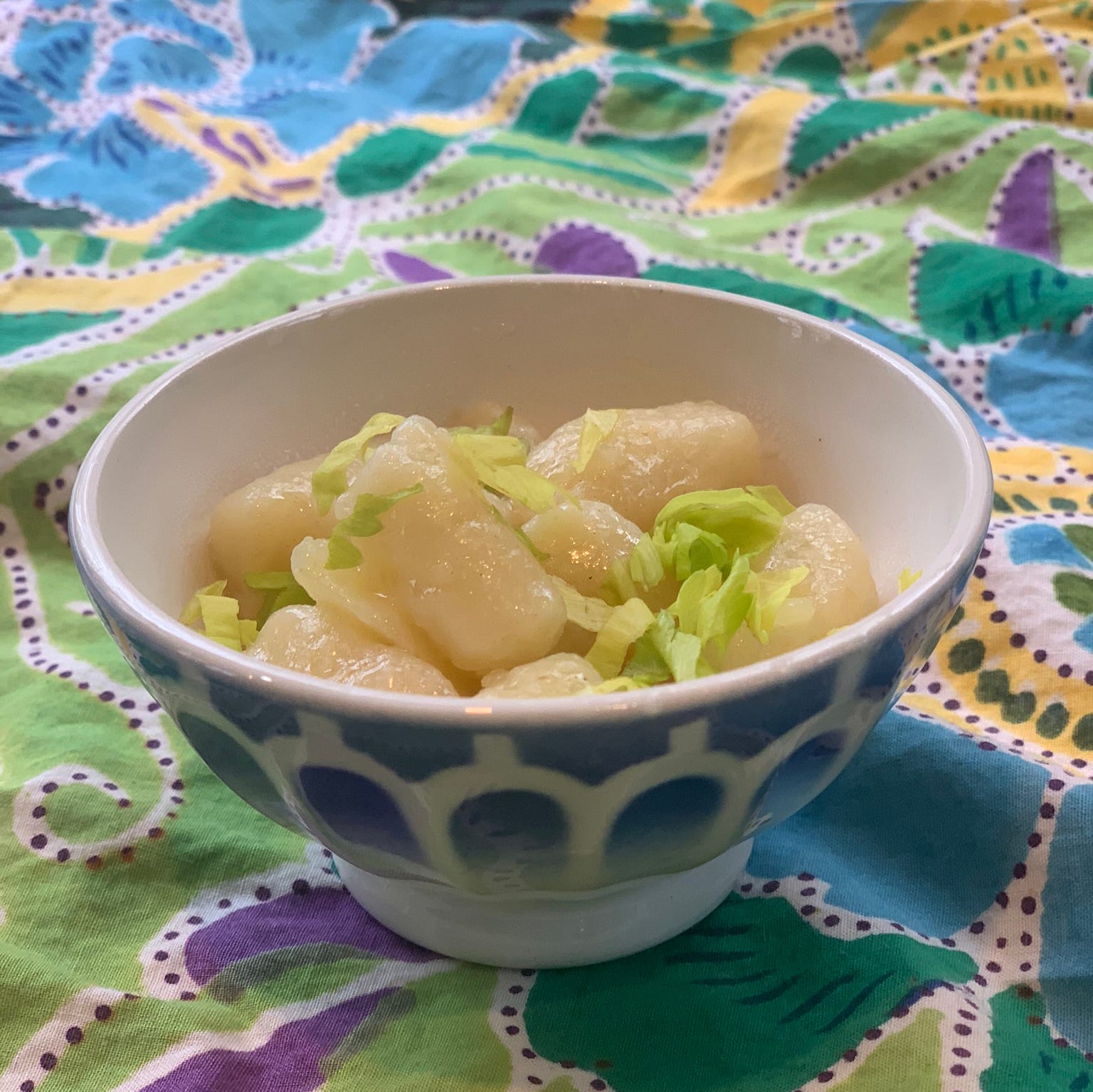
Cindy Sherman was raised in an average Episcopalian family on Long Island. Her oldest sister left home at sixteen to marry and start a cooking school. Sherman was only one at the time.
In interviews, Sherman relates scant information about her youth. Her childhood was somewhat solitary and challenging. Her stories rarely note food. She spent much of her youth, not surprising, playing dress up.
Sherman’s works and interest made her inclusion in a 2014 article in Wallpaper Magazine about artists and food surprising. Sherman contributed a recipe, gnocchi with sage and butter sauce. The recipe is fairly easy, though Sherman warns, “This step is more complicated to explain than it is to execute.”
Cooking with the Collection is made possible with support from the Henry V. and Frances W. Christenson Foundation and the Samuel Reese Willis Foundation.
Read MoreContact Paper Collage
Gina Thomas McGee, Curator of Education
How many times have you cleaned your house this week? Four thousand? Me, too. Which is why I’m here with a VERY low-mess collage project for you and/or your family today.
Here is what you’ll need:
Clear contact paper
Masking or painter’s tape
Scraps for collage- wrapping paper, tissue paper, ribbons, paper, anything relatively flat
The process:
- Choose a spot for your collage. I love doing this on a window so the overall effect is like contemporary stained glass.
- Tape the contact paper to your chosen surface with masking tape. I like to do this before I peel off the contact paper backing, so the paper doesn’t stick to itself.
- Make sure the sticky side of the contact paper is facing UP
- Peel the backing.
- Collage! Simply place your scraps in any arrangement on the sticky side of the contact paper.
This is a great self-directed project for children, who can work on the collage in spurts (while you’re cleaning, again. Or working at home. Or taking a shower. Or hiding in your room eating their Easter candy.) They won’t need scissors, glue, or snacks. Just kidding, they’ll still need snacks.
Adults, this is a great project for days when you want to step away from your phone or computer. The process is really satisfying and even meditative.
Good luck and enjoy! We’d love to see your finished pieces.
#TryThis is made possible with support from PNC, the Mary S. and David C. Corbin Foundation, the Alan and Janice Woll Family Fund, OMNOVA Solutions Foundation, Peg’s Foundation, Robert O. and Annamae Orr Family Foundation, Kathy Moses Salem Philanthropic Fund of the Akron Community Foundation, Charles E. and Mabel M. Richie Foundation and Mr. and Mrs. William H. Considine

Crossword April 26, 2020
Join us every week for a puzzle inspired by museums around the world.

Play online. Or download a pdf. (Last week’s answers.)
This week’s participating museums are The Aerospace Museum of California, Agnes Etherington Art Centre, Akron Art Museum, Berkeley Art Museum and Pacific Film Archive (BAMPFA), Billings Estate National Historic Site, Canadian Museum for Human Rights, Contemporary Jewish Museum, Dumbarton House, Erie Canal Museum, Genesee Country Village & Museum, Joliet Area Historical Museum (and Old Joliet Prison), Lombard Historical Society, McMaster Museum of Art, Royal Saskatchewan Museum, The Georgia Museum of Art, The Pueblo Grande Museum, The Ringling, The Susan B. Anthony Birthplace Museum, The Wolfsonian–FIU, and The Woodrow Wilson House.
Across
1
Not eat
6
The Yankton Dakota Sioux activist in House #6 played this musical instrument. The Susan B. Anthony Birthplace Museum has a hint.
7
Among the last great ukiyo-e artists of this country, Taiso Yoshitoshi (1839–1892) reigned supreme for his daring prints based on various tales and legends. Berkeley Art Museum and Pacific Film Archive (BAMPFA) can offer a hint.
8
Atlanta artist Kevin Cole makes art inspired by this men’s accessory and the fight for black suffrage. The Georgia Museum of Art has a hint.
10
This 1950s era jet engine is still the fastest flying jet engine in history and could operate at Mach3+. Learn more at the Aerospace Museum of California.
12
Once a bone
14
The first Secretary of the United States Navy. Dumbarton House has a hint.
18
Whitling
19
President Wilson Wrote his speeches on a Hammond _______featuring a curved keyboard and multiple fonts. The Woodrow Wilson House can help.
20
Often recognized as Canada’s first paleontologist, his formal education was in law. Learn more at the Billings Estate National Historic Site.
22
Wolfsonian founder Mitchell “Micky” Wolfson, Jr. purchased a c. 1876 sideboard by designer E. W. Godwin from this legendary British guitarist, first name Jimmy. Learn more at The Wolfsonian–FIU
24
Wire form
26
This singer-songwriter, who grew up as a “nice Jewish girl” from North London, rose to international success, however briefly and tragically; she was called “the pre-eminent vocal talent of her generation,” by the BBC. Learn more at the Contemporary Jewish Museum.
27
Artist Natalka Husar often paints herself as one of her two alter egos. One is a _____ to represent the artist as both prober and healer of wounds. McMaster Museum of Art has a hint.
33
Dinosaur hunter, in a way
35
Dig
36
Sap
37
Tracks Across Sheldon Peck Art Work. Learn more at the Lombard Historical Society.
38
Old bird
Down
Down
2
Sap Maker
3
Natural history display
4
Box
5
Syrup once
9
This Rochester, NY native founded a picture-perfect company. Genesee Country Village & Museum is the place to learn more.
10
Art of Stuffing
11
Historic site for opening of Blues Brothers. Joliet Area Historical Museum (and Old Joliet Prison) is the place to learn more.
13
Arthropod of old
15
Pertaining to a period of time between AD 1–1200 BC. Learn more at the Pueblo Grande Museum.
16
Dinosaur’s descendent
17
In a portrait by this Spanish, King Philip IV was originally shown wearing armor, but a change of wardrobe was just one of the many modifications the artist made as he created this powerful image of the king. Learn more at The Ringling.
21
Who is the human rights defender pictured on the new Canadian $10 bill? Learn more at the Canadian Museum for Human Rights.
23
Sample
24
The original Erie Canal, completed in 1825, had 83 of these, built to take the artificial waterway over streams, rivers and other unreliable bodies of water. Explore the Erie Canal Museum for more.
25
To stand straight and to place hands on hips and elbows pointed outwards. Learn more Agnes Etherington Art Centre.
28
Wall-mounted sculpture
29
Largest living member of the deer family; solitary and does not typically befriend squirrels. Royal Saskatchewan Museum can give you a hint.
30
Affix
31
A type of pie depicted by Oldenburg. Learn more at the Akron Art Museum.
32
Malleable
34
A sack to dip and a muse for Oldenburg. Learn more at the Akron Art Museum.
Read MoreSpringtime Tour
Take a walk outside without ever leaving your couch!
Hello art lovers — Reggie Lynch, Curator of Community Engagement, here again with another peek at the Akron Art Museum’s permanent collection. This time, in celebration of Earth Day this week, I’m focusing my tour on works that celebrate spring. I know as I take my socially-distanced walks around my neighborhood, it’s been a big relief to see spring flowers poking their heads through the soil. I’m hoping this digital spin through the museum might do the same for you.
Charles H. Davis, And Southward Dreams the Sea, undated
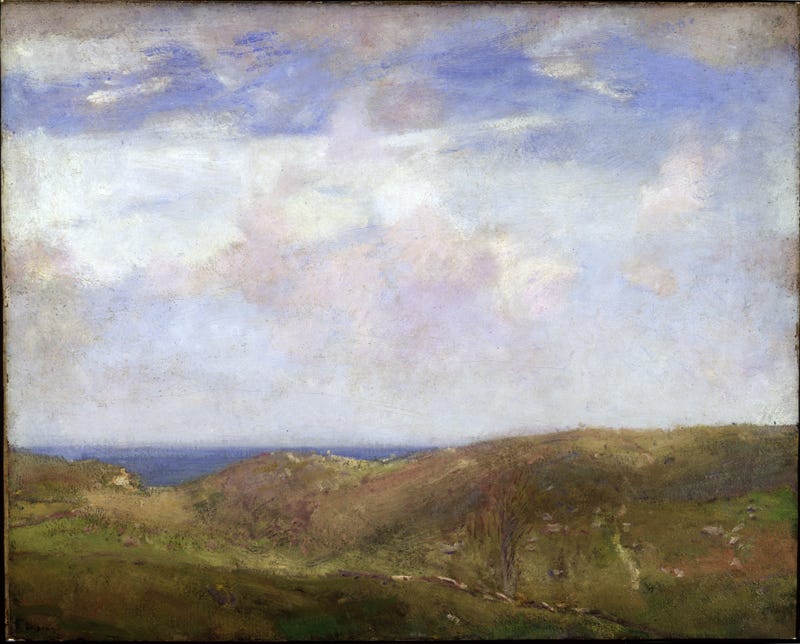
Maybe it’s my Irish ancestors calling out from the past, but this work has always spoken to me. The exact location of the scene is unknown, and the artist isn’t thought to have traveled to Ireland, but the big blue sky and distant sea below gets me wistful for the blustery spring hills of Ireland. The work’s title, And Southward Dreams the Sea, is likely a reference to the poem “Daisy,” by Francis Thompson, in which the speaker recalls an amorous encounter in a scene much like this one. The title of this work appears in the second stanza of the poem:
The hills look over on the South,
And southward dreams the sea;
And with the sea-breeze hand in hand
Came innocence and she.
Paul Stankard, Brown-Eye Susan bouquet with figures, 1996
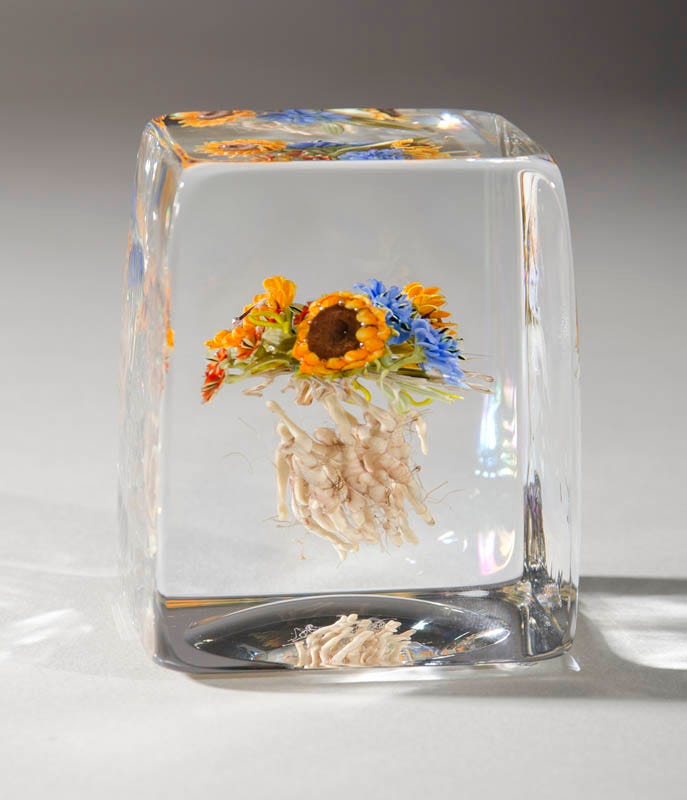
The Paul Stankard Glass Collection is displayed on the museum’s second floor in a cozy niche that I often walk by as I go to my office in the morning. Each time I do, I’m always surprised to find new details in each little scene. These glass sculptures play on the traditional glass paperweight form, which reached its height of popularity in France during the 19th century. The small figures, flowers, and insects that fill Stankard’s works are entirely made of glass, using a process called flameworking. His minuscule worlds explore cycles of birth, decay, and the unseen forces that usher in these changes. As I’ve walked around my neighborhood these last few weeks, slowly taking in the miniate of spring, these vignettes have popped into my mind.
John Henry Twatchman, The Winding Brook, 1887–1900
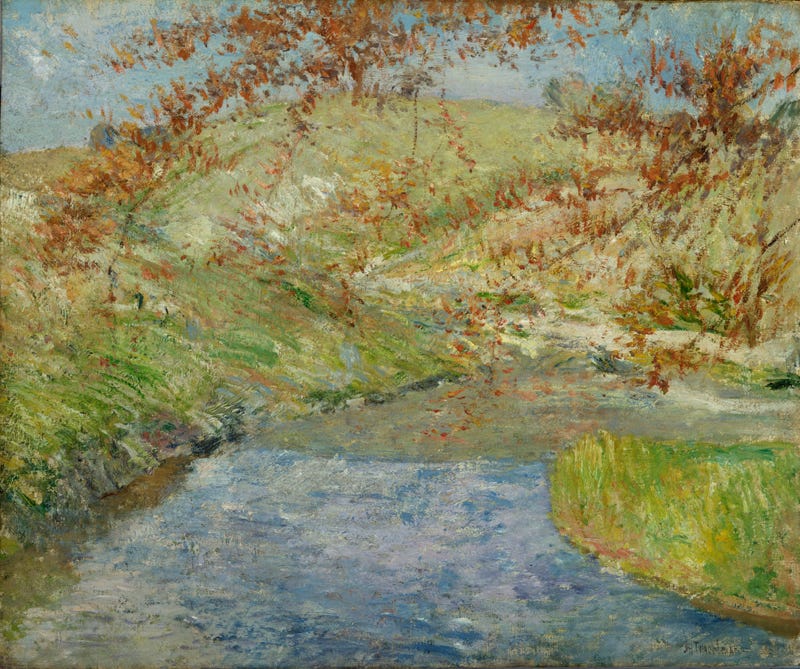
Childe Hassam, Bedford Hills, 1908


In looking through the museum’s archives, I found myself drawn to this pairing of John Henry Twachtman’s The Winding Brook with Childe Hassam’s Bedford Hills from a past exhibit Landscapes from the Age of Impressionism (2011). Their place next to one another perfectly encapsulates nature’s diametric pinnacles of color, with Twatchman capturing nature’s autumnal reposing breath, and Hassam showing nature’s first signs of spring. Both artists were early champions of American Impressionism, which was an art movement that prized brightly colored representations of nature. Hassam often went so far as to directly apply paint from the tube to the canvas, as opposed to first mixing pigments to lower their contrast. Often when giving a tour, I’ll stop the group in front of one of these works and ask them to quietly place themselves in the scene. What smells are wafting along on the breeze? What rhythms are playing out in the meandering stream? Can you feel the sun warming your cheeks?
Tiffany Studios, Hanging Head Dragonfly Lamp, after 1902
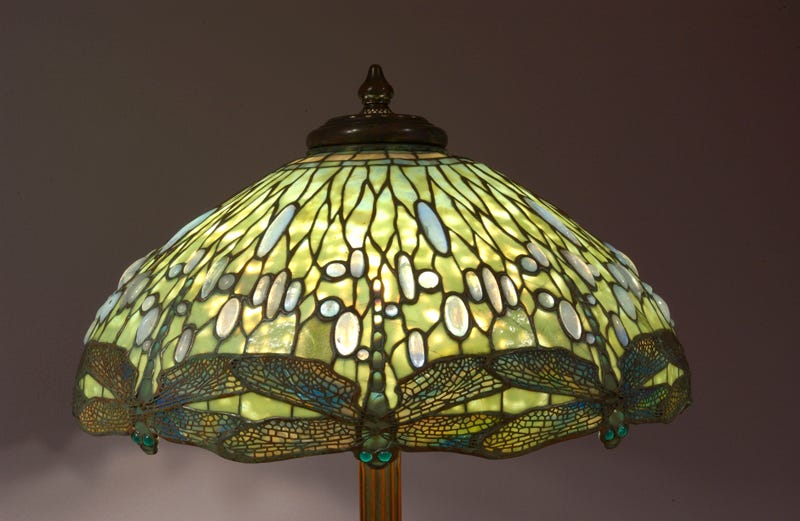

Not all landscapes are paintings. Some of the best depictions of nature from the 20th century were created by Louis C. Tiffany and his Tiffany Studios. Tiffany was an advocate for the Art Nouveau and Aesthetic movements, which focused on showcasing beauty and craftsmanship above all else. Nature and sinuous lines were staple features of both these movements. In this lamp, dragonflies hover at the edge of a dappled green shade, as if poised on the banks of a rippling spring pond. The shade’s abstract pattern also mimics the delicately webbed texture of a dragonfly’s wing. Furthering this natural theme, the base of the lamp was designed to look like a cluster of pond reeds that extend up from a water lily. The overall effect is one of quiet contemplation. You can almost hear the trees rustle as a breeze lifts these dragonflies through the air.
Thanks for joining in on this mini-nature walk through the collection. If you’re feeling curious about the rest of the museum’s landscape collection, you can always check out more of those works here.
Virtual Tours are made possible with support from the Sandra L. and Dennis B. Haslinger Family Foundation, The Sisler McFawn Foundation, The Welty Family Foundation, Dana Pulk Dickinson, and the Lloyd L. & Louise K. Smith Memorial Foundation.
Read More#MuseumGames #Crossword April 19, 2020

The weekly crossword features museums from around the world. This week’s museums include Air Force Space & Missile Museum, Albright-Knox Art Gallery, Ancient House Museum of Thetford Life (part of Norfolk Museums Service), Berkeley Art Museum and Pacific Film Archive, Canadian Museum of History , Cummer Museum of Art & Gardens, Fenton History Center, George C. Marshall Museum & Library, Georgia Museum of Art, Henry Plant Museum, The Nasher Sculpture Center, Pueblo Grande Museum, Stories of Lynn, Studio Art Quilt Associates, The Contemporary Jewish Museum, The Franklin Institute, The Kimbell Art Museum, The Lynn Museum (part of Norfolk Museums Service), The Meadows Museum, The Museum of Early Trades & Crafts, The Royal Saskatchewan Museum, The USS Constitution Museum, The Westerville History Center & Museum, The Wolfsonian–FIU, and the USC Fisher Museum of Art.
To play online. To print a pdf. (Last week’s answers)
Across
2
Opposite of verso
5
Skip
7
Character archetype possessed of secret knowledge and a disregard for conventional behaviour, named Wi-sa-ke-cahk by the Cree, Nanabush by the Saulteaux, Inktome by the Dakota and Nakota, and Sagija’k by the Dene. Learn more at the Royal Saskatchewan Museum.
8
Receiver of printer’s ink
11
During WWI, a political pressure group called the Anti-Saloon League published political cartoons to turn American sentiment against German ____ living in the U.S. & gain support for national alcohol Prohibition. The Westerville History Center & Museum is the place to learn more.
13
Star
14
The Jessie Street Power Substation, which is now home to The Contemporary Jewish Museum, was damaged during this major disaster of April 18, 1906. Learn more at the Contemporary Jewish Museum.
16
Benjamin Franklin created this musical instrument after seeing performers make music with glasses of water. Learn more at the Franklin Institute.
19
As an important figure in the _______ _________, Augusta Savage worked with other important leaders, writers, musicians, and artists to celebrate the contributions of African American culture to American society. Learn more at the Cummer Museum of Art & Gardens.
21
Not recto
23
Twice
25
The U.S. Air Force operates the Eastern Range, which is a historic 10,000 mile rocket testing range that begins at Cape ________ and extends through the south Atlantic to the Indian Ocean. Learn more at the Air Force Space & Missile Museum.
30
World-renowned Canadian architect or brilliantly coloured songbird. Canadian Museum of History has a hint.
32
The figures in this painting by Winslow Homer are enjoying a quiet game of ______ in the countryside. The Albright-Knox Art Gallery is the place to learn more.
34
Pottery decorated with three or more colors. Learn more at the Pueblo Grande Museum.
35
At first glance, this object may look only decorative, when in reality it is a _____. The Henry Plant Museum can offer a hint.
36
In the sculpture “Flowers in a Vase,” Pablo Picasso modeled clay flowers using ___________ molds. Learn more at the Nasher Sculpture Center.
37
Art quilter Carole ___ or metal paper fasteners. Studio Art Quilt Associates has a hint.
38
A shepherd’s concern. The Meadows Museum has a hint.
Down
1
Early animation device invented by English mathematician William George Horner in 1834. Learn more at The Museum of Early Trades & Crafts.
3
Cup or cheese
4
General George C. Marshall pushed this all-terrain vehicle into production during WWII. Learn more at the George C. Marshall Museum & Library.
6
After his stunning 1812 victory, Captain William Bainbridge commissioned this artist to paint his portrait. Unfortunately, they disagreed on the way the uniform was portrayed and eventually another artist was hired to finish. The USS Constitution Museum has a hint.
9
Sculptural wall hanging
10
Wetlands where printmaker Victoria Hutson Huntley made images of bird life. Learn more at the Georgia Museum of Art.
12
Where was Frederick Savage who made merry-go-rounds born in 1828? The Lynn Museum (part of Norfolk Museums Service) has a hint.
13
Snippers
15
An early hire of Frank Lloyd Wright and the person largely responsible for his design drawing style, this female architect (first name) worked with her husband to design Melbourne’s famed Capitol Theatre. Learn more at The Wolfsonian–FIU.
17
22nd Governor of New York State, lived in Jamestown NY. Learn more at the Fenton History Center.
18
What league was a group of powerful trading towns and cities around the Baltic and North seas which included Kings Lynn? Learn more at Stories of Lynn.
20
Where baby places their head
22
What is the surname of the warrener who lived in part of what is now Ancient House in 1901? Learn more at the Ancient House Museum of Thetford Life (part of Norfolk Museums Service).
24
American neo-conceptual artist Jenny Holzer created the installation called ________ in response to the intimidation of artists, teachers, and countless other citizens during the McCarthy Era. Learn more at the USC Fisher Museum of Art.
26
Popular Hindu god worshipped as a remover of obstacles and bestower of good fortune, prosperity, and health. The Kimbell Art Museum has a hint.
27
Whiskey
28
This renowned art museum and film center holds the world’s largest collections of Hans Hofmann paintings, African American quilts, and 35mm Japanese film prints (outside of Japan). What is the acronym to abbreviate its name? Here is a hint.
29
Patricia for short
31
Hard or crystal
33
Type of chocolate
35
Felines
MuseumGames are made possible by PNC with additional support from the Kathy Moses Salem Philanthropic Fund of the Akron Community Foundation, The R.C. Musson and Katharine M. Musson Charitable Foundation, the Robert O. and Annamae Orr Family Foundation, and the Charles E. and Mabel M. Ritchie Foundation

How are you? Really.
Really. Hopefully, you’re finding time to care for yourself amidst strange schedules, social distancing, and lots of time at home. If you need a little help, hop on this self-care tour and let artwork from the collection lead the way.
First Stop: Time for a Retreat!
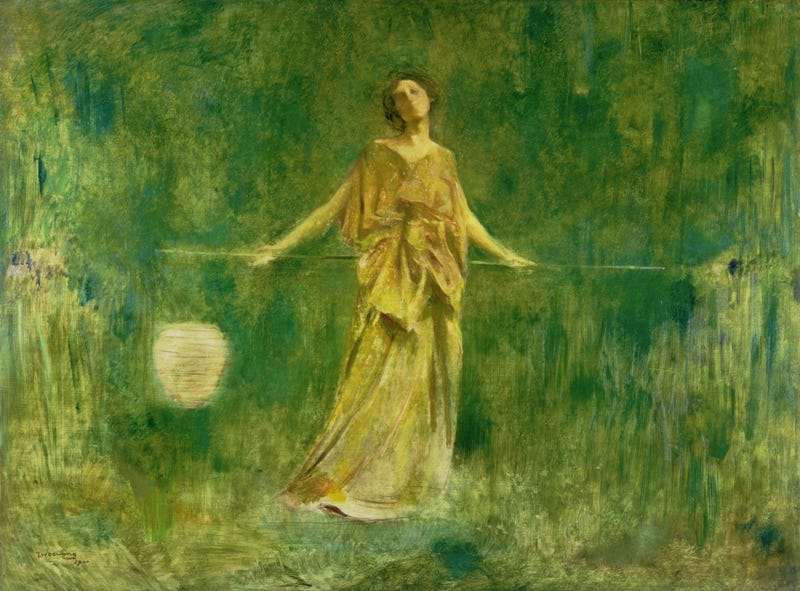
The artist behind this dreamy scene liked to gather up his painter friends, head into nature, and spend time away from the hustle and bustle of their everyday lives.
Your turn: Take a seat and imagine your ultimate relaxing vacation.
Where would you go? Who would you bring?
Next Stop: #goals
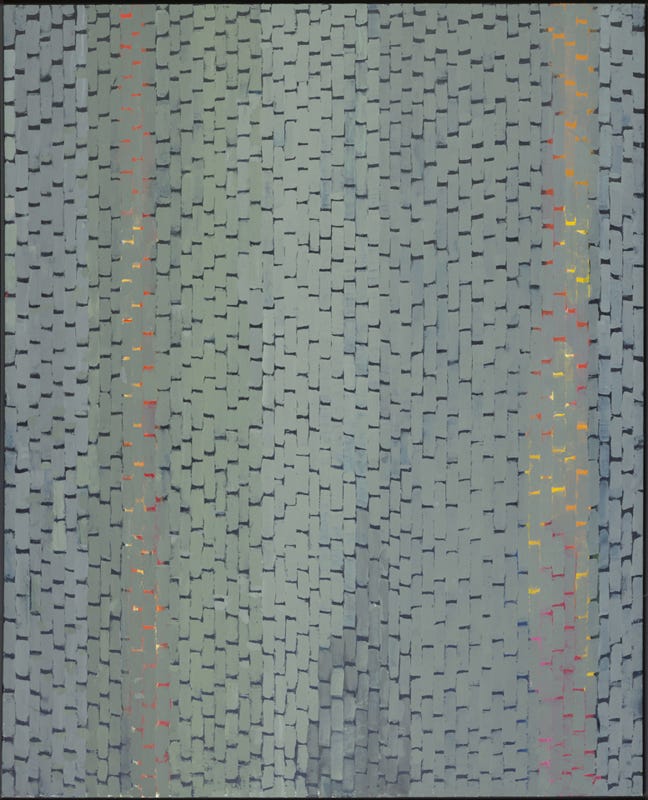
Acrylic on canvas, 68 in. x 55 in. (172.72 cm x 139.7 cm), Gift of Mr. and Mrs. David K. Anderson
After retiring from her career as an art teacher in 1960, this artist devoted herself fulltime to making art. She eventually became the first African American woman to have a solo exhibition at New York’s Whitney Museum of American Art. How’s that for a retirement plan?
PSSST: This artwork has a secret. It looks abstract but the colors, lines, and shapes here are meant to represent a pond in the spring. Head to your window and see how many signs of spring you can spot. If you have time, head out and take a few deep breaths surrounded by nature.
Next: Meditation

This painting is not just a painting. It is a tool for meditation. Rothko considered these floating rectangles doorways between the physical and spiritual worlds.
OOOOM: Sink into this deep pool of blue and see if you can clear your mind. Here are some meditation 101 tips to get you started
1. Get comfortable
To get started, it doesn’t matter whether you sit or lay down as long as you are comfortable. You can sit cross-legged, on the floor, or on a chair. If you can sit erect, then great. If not, it’s just important to have your body in a somewhat stable position. Then have the palms of your hands face the sky.
2. Become “present”
Become totally aware of your current surroundings. What do you hear? How does it feel to sit? Do you feel tension? Where are your thoughts?
3. Focus on your breath
As you take long and deep breaths, feel your breath move from your lungs and out through your nostrils or your throat. (Breathing through your nostrils is better though either will work). Your mind will wander (which is okay), just try your best to be as focused as possible.
4. Feel your body
Once you’re focused, take notice of your body and how each body part feels. Start with the toes and work your way up to your head. If your mind continues to wander, bring your thoughts back to your breath. Breathe 5 to 10 times with full concentration on each breath.
Take it a step further and hum “Om” as you breathe out.
Next Stop: Party Time

Yes, relaxing is nice, but so is blowing off some steam with your best buddies by your side. These ladies sure know how to go glam for a night on the town.
JUST DO IT: Get out your phone right now. Yes, now. Send a message to one person you like (friend, colleague, family) and set up a time to connect by phone or video chat. How about a digital dance party?
Next stop: No News is Good News
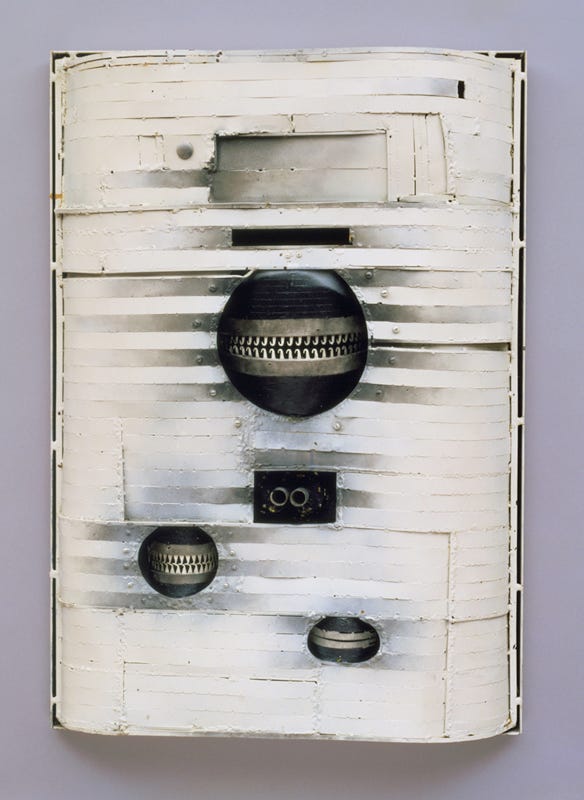
This artist was profoundly affected by World War II and has poignant memories of her mother wiring submarine parts in a factory during the war. These early experiences awakened a lifelong political awareness that fueled the intensity of much of her work.
She Said: “I was angry. I used to work with the United Nations program on the short-wave radio in my studio. I used it like background music, and in a way, the anger became part of the process. During World War II we’d been too young. But at that later time [the 1950s and 1960s], all the feelings I’d had back then came to me again.”
COOL DOWN: What strategies do you use to deal with anger or disappointment? Do you angry-clean your house? Go for a walk? Call a friend? Use the tools that work for you to find calm.
Finally: Treat Yourself

This elaborate scene contains lots of yummy treats
(and super low prices!)
YUMMM: What is your favorite comfort food? Jot it down and make a plan to add the ingredients to your shopping list (or take-out rotation).
Need more? Search the collection database for anything you find calming. Just type in a keyword, year, or artist and let the journey begin.
Read MoreTry This: Shaving Cream Marbling

Art projects at home always SOUND like a good idea, until you think about the set-up, tear-down and clean-up (especially with children, amirite?!) Have no fear, this technique yields incredible results with few supplies, little effort, and minimal mess. I did it in about six minutes with my four year old and no people or household items were harmed. Let’s jump in, shall we?*
Supplies:
Shaving cream (foaming, not gel)
Liquid food coloring or liquid watercolors
Shallow pan or tray
Paper
A tool for stirring (bamboo skewer, plastic knife, etc)
Squeegee or piece of cardboard for removing shaving cream from paper
Paper towels, wipes, or towels
The HOW:
Gather all of your supplies. Here was our dining room set-up. That blue tray is the lid to a storage container.
Fill your tray with a shallow layer of shaving cream. Just enough to coat the bottom of the tray is fine.
Spread evenly. Remind yourself this is NOT whipped cream.
Squirt several drops of each color onto the surface of the shaving cream.
Swirl colors around in shaving cream.
Place paper on top of shaving cream and pat lightly, just so the paper makes even contact with the shaving cream.
Pull your paper off and lay flat on your table or tray.
Squeegee off all shaving cream with squeegee or cardboard.
MARVEL at your talent. The best part is the paper and coloring will be DRY as soon as you get all of the shaving cream off. So, no mess and no drying time. WIN!
Now that you’re feeling confident, feel free to use the same tray again. You can add more colors or simply use what is in your pan as long as there is color to pick up.
Use your beautiful paper as stationary, frame it, wrap gifts with it, the possibilities are endless. If you tackle this project, post photos and tag the museum. Happy Marbling!
Optional follow-up activities:
Let children bring the finished tray full of shaving cream into the bathtub and play with the foam to their hearts’ content and then wash the remainder down the drain. The food coloring WILL stain hands, but will come out after a few generous washings with soap.
#TryThis is made possible with support from PNC, the Mary S. and David C. Corbin Foundation, the Alan and Janice Woll Family Fund, OMNOVA Solutions Foundation, Peg’s Foundation, Robert O. and Annamae Orr Family Foundation, Kathy Moses Salem Philanthropic Fund of the Akron Community Foundation, Charles E. and Mabel M. Richie Foundation and Mr. and Mrs. William H. Considine.

#5WomenArtists at AAM
Akron Art Museum showcases Modern and Contemporary art in its beautiful setting in Northeast Ohio. The museum onsite galleries are closed to the public as part of the public health efforts. But, our online galleries are available, as they always have been, 24×7. We’ll be regularly posting virtual tours on all our social platforms, so you may enjoy the #MuseumatHome.
My Name is Reggie Lynch and I’m the Curator of Community Engagement at the museum. I work to make sure the museum’s programming and interpretation are relevant and accessible to our community.
Can you name #5womenartists? I certainly can! Follow along on this virtual tour to learn a little bit about some artists from the museum’s collection who changed the course of history.
1. Alma Thomas, Pond — Spring Awakening, 1972
After retiring from a 38-year career as an art teacher, Alma Thomas would go on to spend the last 18 years of her life gaining significant recognition for her abstract work. Thomas created this workin the same year that she became the first African-American woman to be featured in a solo exhibition at the Whitney Museum of American Art. In this image, one of the Akron Art Museum’s educators is challenging a group of students to think about how Thomas’ abstraction got its title: Pond — Spring Awakening. I’ve had students in the galleries who swear they see koi swimming in this pond!
2. Viola Frey, Woman and the World,
Viola Frey was a pioneering ceramicist whose monumental sculptures pushed ideas of what ceramics can be as a medium and as a mode of expression. Most frequently, these sculptures explore themes of gender and identity. During the summer of 2019, Frey’s Woman and the World was a centerpiece of a dance performance at the Akron Art Museum in partnership with NCCAkron and DANCECleveland. Whenever I see this piece, I’m never sure whether the woman is turning her back on the world or is about to pick it up and carry it on her back. What do you think?
3. Yayoi Kusama, Arm Chair, 1963
Yayoi Kusama and her career are a master class in determination and perseverance. Although she faced childhood traumas and continues to struggle with her mental health, by 1993 her talent was so undeniable that Japan named her as the first woman to represent the country at the prestigious Venice Biennale. This image from the 1970s is from the museum’s Archives and the work was created during one of Kusama’s most prolific phases. For Kusama, art has continually been a way to channel her difficult thoughts and bring viewers into her state of mind. For me, viewing and making art always makes me feel connected to other people and distracts my sometimes anxious thoughts. What does making or viewing art do for you?
Image taken from the museum’s archives
4. Jenny Holzer, All Fall Text: Selections from Truisms, (1977–79), Living, (1980–82) and Survival, (1983–85), 2012
Ohio native Jenny Holzer is best known for her provocative works that use phrases and words to question societal structures. Her early works were mostly 2D, but in 1982 she installed her first electronic sign in the middle of Times Square. With its colorful, busy lights, this work is meant to recall that installation and more than once I’ve caught visitors taking a long look as they try to read the full message. It often gets me thinking: what would I say if I could run text through Times Square or at a museum? What do you think — what would you say?
Imagine taken during the 2020 Midwinter Blues Concert at the Akron Art Museum
5. Helen Frankenthaler, Wisdom, 1969
Last, but certainly not least, is my personal favorite from our collection by Helen Frankenthaler. Very often, I’ve had conversations with people about how abstract works like this shouldn’t be considered art and I’ve heard the ever-popular argument “My kid could do that!” I get it! Abstract art isn’t for everyone, and that’s okay. But here’s where I get defensive of Frankenthaler: she and the other abstract painters of her day did this before anyone else thought to do it and she did it in a way that no one else was doing at that time. She invented a new technique called soak-stain, in which the canvas hasn’t been primed, so the paint soaks through the cloth canvas, creating soft pools and edges to the puddles of paint. She didn’t believe there were ever mistakes in art but thought instead about how a “wrong turn” was just a chance to take a different perspective. I’ve found myself coming back to this piece over and over. I’ll often let my gaze go soft and just rest in the warm colors and soft lines. To me, this work is peaceful and energizing all at once. Do you have any works of art that make you feel this way?
And that’s that. If you had trouble naming 5 women artists before this, now you’re an expert! Keep these pioneering women in mind when we reopen — you never know how they might strike you!
Virtual Tours are made possible with support from the Sandra L. and Dennis B. Haslinger Family Foundation, The Sisler McFawn Foundation, The Welty Family Foundation, Dana Pulk Dickinson, and the Lloyd L. & Louise K. Smith Memorial Foundation.
Read More#MuseumGames #Sudoku April 12

The Akron Art Museum works with museums around the world to create weekly crosswords and other puzzles. This week, we’ve added a Sudoku puzzle. Museums have a few clues to help you get through the puzzle.
Participating Museums: Academy of Motion Picture Arts and Sciences; Allentown Art Museum; Ancient House Museum of Thetford Life (part of Norfolk Museums Service); Antique Gas and Steam Engine Museum; Appleton Museum of Art, College of Central Florida; BAMPFA ; Canadian War Museum ; Contemporary Jewish Museum; Delaware Art Museum; Erie Canal Museum; Fairfield University; Georgia Museum of Art; Getty; Hammer Museum at UCLA; Holden Arboretum; Kean University Galleries; Kimbell Art Museum; Long Island Children’s Museum; New-York Historical Society; Old World Wisconsin; Peabody Essex Museum; Poster House; Pueblo Grand Museum; Royal Saskatchewan Museum; San Antonio Museum of Art; Stories of Lynn; The Delaware Natural History Museum ; The Johnson Collection; The Lynn Museum (part of Norfolk Museums Service) ; University of Michigan Museum of Natural History; Westmoreland Museum of American Art; Wolfsonian-FIU
CLUES
A. How many daughters did Maharajah Duleep Singh have? Learn more at Ancient House Museum of Thetford Life (part of Norfolk Museums Service).
B. Part of how the Stenberg Brothers signed their posters. Learn more at Poster House.
C. Due to an increased loss of biodiversity, scientists are discussing whether the earth is undergoing another mass extinction. If so, how many mass extinctions would the Earth have experienced? Learn more at the University of Michigan Museum of Natural History.
D. The Delaware Natural History Museum has 3?, 000 egg clutches.
E. While working as a ticket collector at a tourist attraction, self-taught artist Minnie Evans sold her drawings for ?0 cents each. The Johnson Collection can give you a clue.
F.On which day of January 1840 did Kings Lynn born writer Fanny Burney die?TheLynn Museum (part of Norfolk Museums Service) can share more.
G. The oldest collection work is an object from 184? at the Antique Gas and Steam Engine Museum.
H. Long Island Children’s Museum was awarded the National Medal for Museum and Library Service, the nation’s highest honor conferred on museums and libraries in recognition of their extraordinary service to the community, in 201?. Learn more at Long Island Children’s Museum.
I. Double of this number or the number of acres of forested land on which the Appleton Museum of Art, College of Central Florida resides.
J. On King’s Lynn Town Hall, which King Charles’ coat of arms is on the porch? Learn more at Stories of Lynn.
MuseumGames are made possible by PNC with additional support from the Kathy Moses Salem Philanthropic Fund of the Akron Community Foundation, The R.C. Musson and Katharine M. Musson Charitable Foundation, the Robert O. and Annamae Orr Family Foundation, and the Charles E. and Mabel M. Ritchie Foundation


